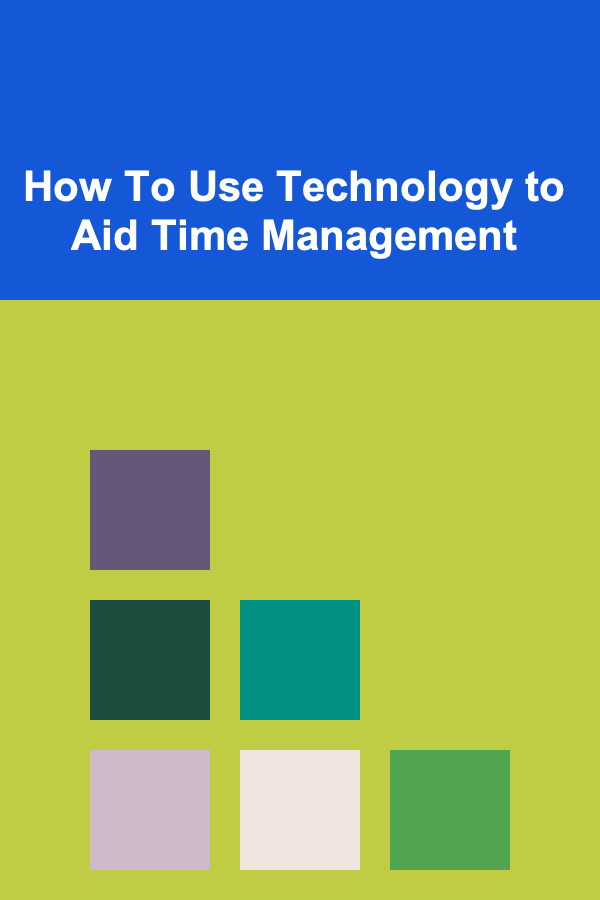
How To Use Technology to Aid Time Management
ebook include PDF & Audio bundle (Micro Guide)
$12.99$8.99
Limited Time Offer! Order within the next:

In today's fast-paced world, time is one of the most valuable resources. With the rise of digital tools and technology, managing time efficiently has never been more accessible. Whether you're a student juggling assignments, a professional managing work deadlines, or an entrepreneur handling multiple projects, technology can play a crucial role in helping you make the most of your time. This article delves into various technological tools and strategies that can aid in time management, offering a comprehensive guide to maximizing productivity.
The Importance of Time Management
Before we explore the technological tools available, it's important to understand why time management is so critical. Time management is the process of planning and controlling how much time you spend on specific activities. It enables individuals to accomplish more in less time, reduce stress, and maintain a healthy work-life balance.
Effective time management helps:
- Increase Productivity: By prioritizing tasks, you can focus on what's important and avoid distractions.
- Reduce Stress: Well-managed schedules help prevent last-minute rushes and missed deadlines.
- Achieve Goals: With a clear plan, you're more likely to stay focused on long-term goals and objectives.
- Maintain Balance: Properly managing time allows for more leisure and personal time, leading to a healthier work-life balance.
With that in mind, technology can assist in the complex task of managing time by providing tools that help individuals plan, organize, and track their time efficiently.
How Technology Can Help with Time Management
Technology offers a variety of tools designed to help individuals optimize their time. From calendars to task management apps and automation tools, there's no shortage of options. Here, we'll examine several categories of technology that can aid in time management.
1. Task Management Apps
Task management apps are designed to help individuals organize their tasks and projects. These apps allow you to break down larger tasks into manageable steps, set deadlines, and track progress. Some of the most popular task management apps include:
Trello
Trello is a visual tool that helps you organize tasks and projects using boards, lists, and cards. You can categorize tasks by their priority, set due dates, assign tasks to team members, and track progress. Trello's simple, drag-and-drop interface makes it easy to visualize your workflow, whether you're working on a single project or managing multiple ones.
Asana
Asana is another popular task management app that focuses on team collaboration. It allows you to create tasks, set deadlines, assign work to team members, and monitor project progress. Asana integrates with a wide range of other tools like Slack, Google Drive, and Dropbox, making it easy to centralize all your work in one platform.
Todoist
Todoist is a straightforward task manager that helps you organize your to-do list. You can categorize tasks by projects, set priorities, and even delegate tasks. Todoist also has a feature called "Karma," which motivates users by rewarding them for completing tasks on time.
2. Calendar and Scheduling Tools
Calendars are one of the most traditional yet powerful tools for time management. With the help of digital calendars, you can organize your day, schedule meetings, set reminders, and avoid scheduling conflicts. Technology enhances traditional calendars by adding smart features and integrations that allow for even greater efficiency.
Google Calendar
Google Calendar is one of the most widely used calendar tools. It allows users to schedule events, set reminders, and share calendars with others. Google Calendar also integrates seamlessly with Gmail, Google Meet, and other Google Workspace tools, making it easy to manage appointments and meetings from a single platform.
Microsoft Outlook
Microsoft Outlook is another popular tool that combines email and calendar features. It allows users to schedule meetings, set reminders, and organize their time effectively. Outlook is particularly useful for business professionals who need to manage both their emails and calendars in one place.
Calendly
Calendly is a scheduling tool that simplifies the process of booking appointments. It allows you to set availability preferences and automatically generates a link that others can use to book time with you. Calendly eliminates the back-and-forth that typically occurs when trying to schedule a meeting, making it a valuable tool for busy professionals.
3. Time Tracking Tools
Time tracking tools help you monitor how much time you spend on specific tasks. By understanding where your time is going, you can identify inefficiencies, eliminate distractions, and focus more on high-priority tasks.
RescueTime
RescueTime is a time-tracking app that automatically records how you spend your time on your computer or mobile device. It categorizes your activities into productive and unproductive categories, allowing you to track your work habits over time. You can also set goals and alerts to ensure you're staying on track.
Toggl
Toggl is a simple, easy-to-use time tracker that allows you to track time across different projects. It's especially useful for freelancers or anyone who needs to bill clients based on the hours worked. Toggl integrates with other tools like Trello, Asana, and Slack, helping you streamline your time management process.
Clockify
Clockify is a free time-tracking tool that allows users to track their time across different tasks and projects. It offers features like reporting and time analysis, making it ideal for individuals and teams who need to monitor time spent on various activities.
4. Automation Tools
Automation tools can help save time by handling repetitive tasks automatically. By automating mundane processes, you can free up more time for higher-value activities that require your focus and expertise.
Zapier
Zapier is an automation tool that connects different apps and automates workflows. For instance, you can create a "Zap" that automatically saves email attachments to Google Drive or posts updates to social media when a new task is added to your project management app. By automating these small tasks, you can streamline your workflow and focus on more important tasks.
IFTTT (If This Then That)
IFTTT is another automation tool that allows you to create "applets" that automate actions between apps and devices. You can use IFTTT to automate a variety of tasks, such as sending an email reminder when a task deadline is approaching or turning on your lights when your calendar shows a meeting.
5. Focus and Productivity Apps
Staying focused can be one of the biggest challenges when managing time. Distractions like social media, emails, and notifications can derail your productivity. Fortunately, there are several apps designed to help you stay focused and avoid distractions.
Forest
Forest is a unique productivity app that helps you stay focused by encouraging you to "plant a tree" whenever you need to focus. As you work, the tree grows, but if you leave the app to check your phone, the tree dies. Forest also allows you to track your focus time and build up a virtual forest, making it a fun and rewarding way to stay on task.
Focus@Will
Focus@Will is a music app designed to improve concentration. It offers a variety of instrumental music tracks that are scientifically engineered to enhance focus and productivity. The app has different channels, such as "Focus," "Relax," and "Boost," so you can choose the best music for your work style.
Freedom
Freedom is an app that blocks distracting websites and apps on your devices. You can schedule focused work sessions and block sites like social media, email, and news outlets. By eliminating these distractions, you can stay focused on your most important tasks.
6. Collaboration Tools
For team-based projects, collaboration tools can help streamline communication, task delegation, and document sharing. These tools can enhance teamwork, ensuring that everyone is on the same page and that tasks are completed on time.
Slack
Slack is a popular messaging platform used by teams to communicate and collaborate in real-time. It supports channels for group discussions, direct messaging, file sharing, and integrations with other tools like Google Drive and Trello. Slack allows teams to stay connected and organized, helping to streamline communication and improve productivity.
Microsoft Teams
Microsoft Teams is another collaboration tool that combines chat, video conferencing, and file-sharing in one platform. It's part of the Microsoft 365 suite, which makes it particularly useful for teams already using other Microsoft tools like Word, Excel, and PowerPoint. Teams helps keep everyone on the same page with shared calendars, meeting scheduling, and project management capabilities.
Best Practices for Using Technology to Aid Time Management
While technology can be incredibly helpful, it's important to use it wisely. Here are some best practices to get the most out of the tools at your disposal:
- Set Clear Goals: Technology can help you track and organize your time, but it's important to set clear, measurable goals before you start using these tools. This way, you can focus your efforts on tasks that matter most.
- Avoid Overloading on Tools: There are many time management tools available, but using too many can overwhelm you. Stick to a few essential tools that integrate well with your workflow and provide real value.
- Customize Tools for Your Needs: Most time management tools offer a wide range of customization options. Tailor these tools to your specific needs and work style to get the best results.
- Review Your Progress Regularly: Technology can help track your time, but it's up to you to analyze the results. Regularly review your progress and adjust your strategies as needed.
- Stay Consistent: Consistency is key when using time management tools. Set a routine and stick to it to ensure you stay on track and make the most of your time.
Conclusion
Incorporating technology into your time management strategy can significantly enhance productivity, reduce stress, and help you achieve your goals more efficiently. By using task management apps, calendar tools, time tracking software, automation services, and collaboration platforms, you can optimize how you spend your time. However, it's important to use these tools wisely, choose the right ones for your needs, and stay disciplined in your approach.
With the right technology at your disposal, time management can become a much more manageable task, allowing you to take control of your schedule and accomplish more, both professionally and personally.
Reading More From Our Other Websites
- [Organization Tip 101] How to Use the FIFO Method (First In, First Out) in Your Pantry
- [Home Budget Decorating 101] How to Rearrange Your Furniture for a Completely New Room Look
- [Scrapbooking Tip 101] How to Incorporate Hand‑Stitched Embroidery into Your Scrapbooking Projects
- [Skydiving Tip 101] Advanced Maneuvers Unlocked: Transitioning from Tandem to Solo Skydiving
- [Personal Financial Planning 101] How to Reduce Your Monthly Expenses Without Sacrificing Lifestyle
- [Home Budget 101] How to Save Money on Gas: Unconventional Strategies for the Everyday Commuter
- [Organization Tip 101] How to Organize Your Kitchen Utensils for Quick Access
- [Sewing Tip 101] Sewing Basics Made Easy: Must-Have Tools and Projects for Absolute Beginners
- [Home Soundproofing 101] How to Soundproof Your Home Without Sacrificing Style
- [Soap Making Tip 101] Troubleshooting Hot Process Soap: Common Mistakes and How to Fix Them

How to Clean Your Ice Maker for Best Results
Read More
How to Create a Cozy Holiday Reading Nook in Your Home
Read More
How to Organize a Small Pantry for Maximum Storage
Read More
How to Set Up an Investment Portfolio That Matches Your Risk Tolerance
Read More
What Are the Best Ways to Organize Your Home Library?
Read More
How To Build a Strong Content Strategy
Read MoreOther Products

How to Clean Your Ice Maker for Best Results
Read More
How to Create a Cozy Holiday Reading Nook in Your Home
Read More
How to Organize a Small Pantry for Maximum Storage
Read More
How to Set Up an Investment Portfolio That Matches Your Risk Tolerance
Read More
What Are the Best Ways to Organize Your Home Library?
Read More